| Published
on 1
Nov
2023 |
All rights reserved.
|
|
|
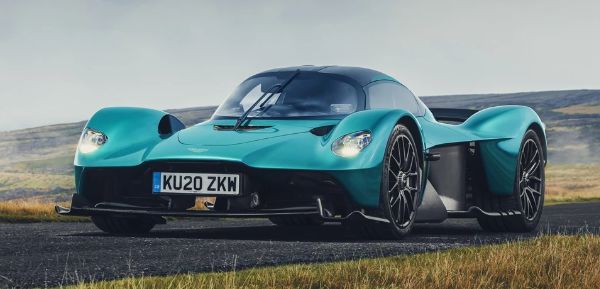 |
|
Valkyrie
is probably the first hypercar to try a step further than race cars...
|
|
Dauer 962LM, Ferrari F50,
Porsche 911 GT1, Mercedes CLK GTR, Jaguar XJR-15 and XJ220, Ford GT40
and GT… many supercars were derived from race cars and reckoned to
deliver the closest driving experience to motor racing. However, Aston
Martin Valkyrie is probably the first to try a step further than race
cars. Modern race cars are tightly governed by racing regulations such
as air restrictor size, fuel-flow limit, engine format and
displacement, dimensions and shapes of aerodynamic aids, suspension
technology and minimum vehicle weight. For example, a Le Mans Hypercar
(LMH) is limited to 670 horsepower, propelling a minimum dry weight of
1030 kg, resulting in a power-to-weight ratio of 650 hp per ton.
Moreover, active aero is banned, while downforce/drag ratio is capped
at 4:1. In contrast, the Aston Martin Valkyrie project started with a
target of
1000 horsepower and less than 1000 kg of dry weight, so its power to
weight ratio is 50 percent higher than that of the top-class Le Mans
racers. By combining ground effect, active aero and active suspension,
it can achieve lower drag while chasing 1800 kg of downforce. Yes, road
car homologation rules actually give engineers more freedom to chase
performance. If the car is fitted with racing slick tires, it will
out-run a
Le Mans car. Aston even claimed it would be as quick as an F1 car in
Silverstone circuit!
To realize such an extreme hypercar, you need to fulfill a couple of
preconditions. Firstly, you should be able to persuade sufficient
customers to pay multi-million dollars for a car that might be very
compromised to be used on road – such as zero luggage space, race-car
tight cockpit, little refinement and comfort. Fortunately, Aston Martin
is still a strong brand, so finding 150 buyers to write a cheque of
£2.5 million (plus local taxes) would not be a big problem. If
that’s not enough to earn a profit, another 25 units of track variant
should capitalize on the investment.
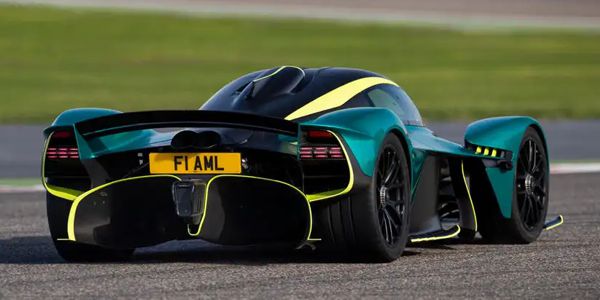
|
|
Redbull
engineering guru takes aerodynamics to the extreme on this
so-called "road car".
|
|
The second precondition is to find the right guy to design
such a car. Obviously, to out-perform state of the art race cars, you
need someone who is riding at the top of the motor racing game. Who
could be a better candidate than Adrian Newey? The F1 engineering guru
designed countless of championship-winning machines for Williams,
McLaren and Red Bull. If he can’t, I don’t know who is capable of.
Newey was not hired by Aston Martin though. The Valkyrie project
started as a partnership between Aston and Redbull Racing. That’s why
the original prototype unveiled in July 2016 was named AM-RB 001. Its
engineering was the work of Newey and his colleagues, while styling was
credited to Aston Martin’s Marek Reichman, although the car is shaped
by the aero know-how of Newey.
In July 2017, a near-working prototype arrived together with the
Valkyrie name. Production was said to take place in 2019, as its V12
motor was under development by Cosworth. In December 2018,
Cosworth had its job done. Unfortunately, Aston Martin fell into
financial trouble at this moment, which led to new owner Lawrence
Stroll and dismissal of company chief Andy Palmer. The partnership with
Redbull ended, and Aston took over the remaining development work. This
delayed its first delivery by 3 years to late 2022.
Apart from delay, the finished product did not meet all the targets set
by Newey. For example, maximum downforce is lowered from 1800 kg to
1100 kg as its suspension has troubles to take on more. Dry weight has
risen from the original 1000 kg target to 1270 kg, blame to the lack of
development fund. On the plus side, the hybrid powertrain exceeds its
original target by 155 horsepower, compensating part of the lost
performance.
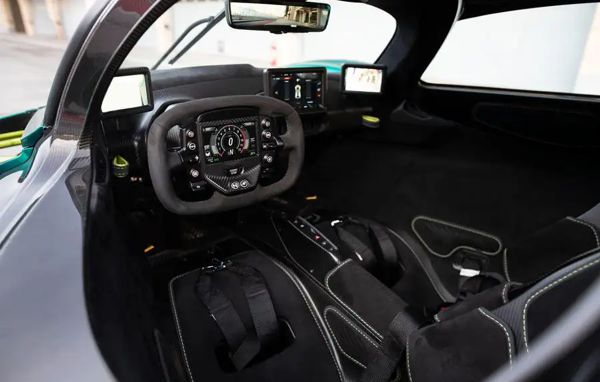
|
|
Cockpit
is so tight and you get in and out through windows.
|
|
Newey is an aero guy, so it is not surprising to see the
Valkyrie is shaped to optimize aerodynamics at all costs of
practicality. While the car is 2-meters wide, its passenger cell is so
narrow, leaving space at either side to accommodate massive venturis
which lead to huge diffusers and generate huge downforce. There is no
luggage compartment up front, not at the back either, because that
would have compromised air flow. You must be grateful that Newey did
not ditch the fenders or leave the cockpit exposed, because they
actually help smoothing the air flow. The rear wing and underbody flaps
are adjustable. As a result, the car produces 1100 kg of downforce from
a relatively low 220 km/h (137 mph), far superior to other track
specials such as 911 GT3 RS (860 kg at 285 km/h) and McLaren Senna (800
kg at 250 km/h).
The carbon-fiber passenger cell is extremely narrow. Moreover, you get
into it from the very small gullwing doors like Le Mans car drivers. In
fact, you might just call the doors as windows, because they open up to
the shoulder line only. This means you have to climb into the cockpit
skillfully – better take some Yoga lessons first. The cockpit has 2
seats but absolutely no shoulder room for both occupants. The seat pads
are molded into the floor to save space like LaFerrari, while pedals
are adjustable to suit. The footwell offsets to the center line as the
carbon-fiber monocoque is shaped like a teardrop. The only luxury item
is as many as 4 LCD screens on offer, but each of them has special
purposes. The one on the racing-style steering wheel displays the
driving information as the car has no instrument pod. The one on the
center console (is it a console?) displays secondary information as
well as rear view from the rearward camera, since the car has no rear
window at all. Likewise, the screens at either side of the dashboard
replace door mirrors. The Valkyrie takes aerodynamics to the extreme.
In racing car fashion, the front suspension is mounted directly on the
carbon-fiber monocoque, while the rear suspension is attached to the
engine which works as load bearing. The Valkyrie employs not just
adaptive dampers but active suspension, which uses hydraulically
actuated torsion bar to alter the force in each suspension.
Theoretically, the characteristics of compression, rebound and ride
height are all adjustable in real time and individually at each wheel.
This means it can achieve flat cornering, eliminate pitch and dive as
well as change stiffness to counteract downforce. Needless to say,
it rides on Michelin Cup 2 tires and uses Brembo carbon ceramic brakes.
The 20-inch front and 21-inch rear wheels are forged from Magnesium.
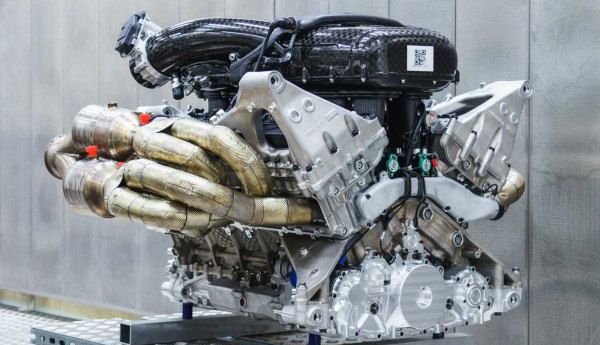 |
|
Cosworth
V12 shames the best of Ferrari and Lambo by revving to 11,100 rpm.
|
|
While Aston itself has some pretty powerful V12 engines, it
wisely commissioned Cosworth to build a brand new naturally aspirated
unit for the
hypercar. It runs 65-degree V-angle and displaces 6.5 liters like
Ferrari’s V12 motors, but its output figures trump the latter by a
large margin: 1013 horsepower is produced at 10,500 rpm, and it can rev
to a maximum 11,100 rpm like a racing motor! For comparison, the most
powerful version of Ferrari’s road-going V12, as employed by 812
Competizione, produces “only” 830 horsepower at 9250 rpm, and it revs
to only 9500 rpm. Moreover, the Cosworth V12 is unusually lightweight
at 206 kg, even though it is designed as a fully stressed member of the
chassis. How can it achieve these?
The answer is by the usual racing engine technologies. To cut weight,
the large intake plenum is made of carbon-fiber while the equal-length
exhaust manifolds are Inconel. To enable higher rev and power, moving
internals are made from the lightest material and in very expensive
ways: forged aluminum pistons, titanium con-rods and a crankshaft
billet machined from a solid block of steel. Lightweight titanium
intake valves and
plasma-coated cylinder walls also allow the engine to rev higher, so
does the lack of particulate filters. The latter is possible
because the V12 employs port injection only, so there is no lean-burn
mode to take care of. To withstand the unprecedent high rev, the
camshafts are driven by gears instead of chains. Lastly but not least,
the Cosworth motor is designed to last only 80,000 km before a full
rebuild. That’s more than the 50,000 km life of AMG Project One’s V6,
but modern Ferrari engines can easily last more than 200,000 km.
The naturally aspirated V12 works with an electric motor which is
integrated with the
Ricardo 7-speed single-clutch automated manual transmission. The motor
provides another 143 horsepower, adding up the total to 1155 hp at
10,600 rpm, accompanied with 682 lbft of torque at 7,000 rpm. The
hybrid system including a small, 1.68 kWh battery, is supplied by
Rimac. It is charged by engine power rather than braking or plug-in.
There is no
EV mode either, just assists the engine in acceleration. The
Ricardo box has an even shorter life than the engine,
requiring a full rebuild
every 50,000 km. Extreme performance never comes cheap.
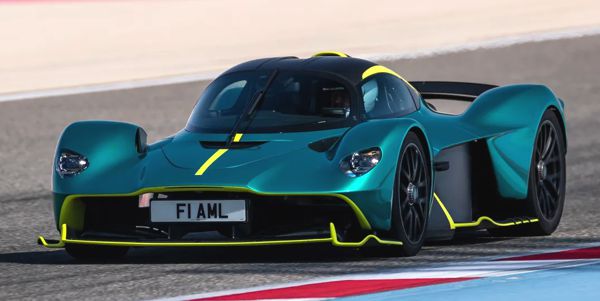
|
|
An
unpolished raw diamond.
|
|
How does this 220 mph hypercar feel in reality? Well, it
gives motoring journalists a mixed impression. On the one hand, its
speed, both in straight line and in corner, is astonishing, easily
trumping track specials like McLaren Senna. On a track with long and
wide straight, the Valkyrie reaches over 200 mph at the end of the
straight whereas the McLaren manages only 180. The combination of a
large naturally aspirated V12 and electric assistance offers a
relentless acceleration. The Cosworth V12 is the highlight of the car,
as it offers all the qualities you expected, like instantaneous
throttle response, linear power delivery and endless enthusiasm for
rev. It is tractable at urban speeds, but it takes about 3500 rpm to
really wake up, then its tone changes with rev. The sound might be less
melodic than Ferrari or Lamborghini’s V12s, but still a very special
noise.
Unfortunately, it is way too loud to enjoy in the uninsulated
carbon-fiber passenger cell. In fact, so loud that you have to wear ear
plugs or the provided active noise-cancelling earpieces to avoid
hearing damage, even in a helmet. What a pity. The cockpit is actually
an NVH laboratory, displaying all sorts of rattles and shakes and
vibrations thanks to bolting the engine directly to the monocoque.
Seating position is like F1 cars, with your legs raised to chest level
to make up space for airflow underneath. You will get used to that, but
never the way your shoulder is rubbed against your passenger or the
immense noise that makes conversation impossible on the run.
In fact, the lack of development is evident everywhere. While the
Valkyrie corners very quickly once it is up to speed with downforce
built up, its low-speed cornering is a bit clumsy, because unlike most
other hybrid rivals it has no front-end traction to rely on. The engine
is simply too powerful for the rear axle, easily overwhelming the Cup 2
tires and triggering traction control to work overtime. Turn off
traction control, the rear tires breakaway suddenly, lacking the
progressive and controllable manner of most other supercars. On racing
slicks it might be a very different animal, but road tires fail to live
up to its potential.
Control tuning is also flawed. The long-travel brake pedal feels
slightly dead at its top end, although braking power is ultimately
epic. Gearshift of the automated manual box is not great either: slow
and rough. The steering has adequate weighting and speed but
communication is a bit lacking. The active suspension has body movement
tied down, but it does so unnaturally, robbing you the feel and
confidence like how Alain Prost complained about his active-suspension
1993 Williams FW15C winner, which was incidentally designed by Adrian
Newey, too. The Valkyrie is not the kind of driver’s car that tries
very hard to engage you with feedback and feel and sound, but it asks
you to trust its capability, lean on it and then it will deliver what
it promised – until the tires give up.
Sadly, the original idea of Newey sounds so promising, but financial
trouble stopped Aston from realizing it, resulting in an unpolished raw
diamond. We will never know how it might turn out if it underwent
proper development.
|
Verdict:    |
|